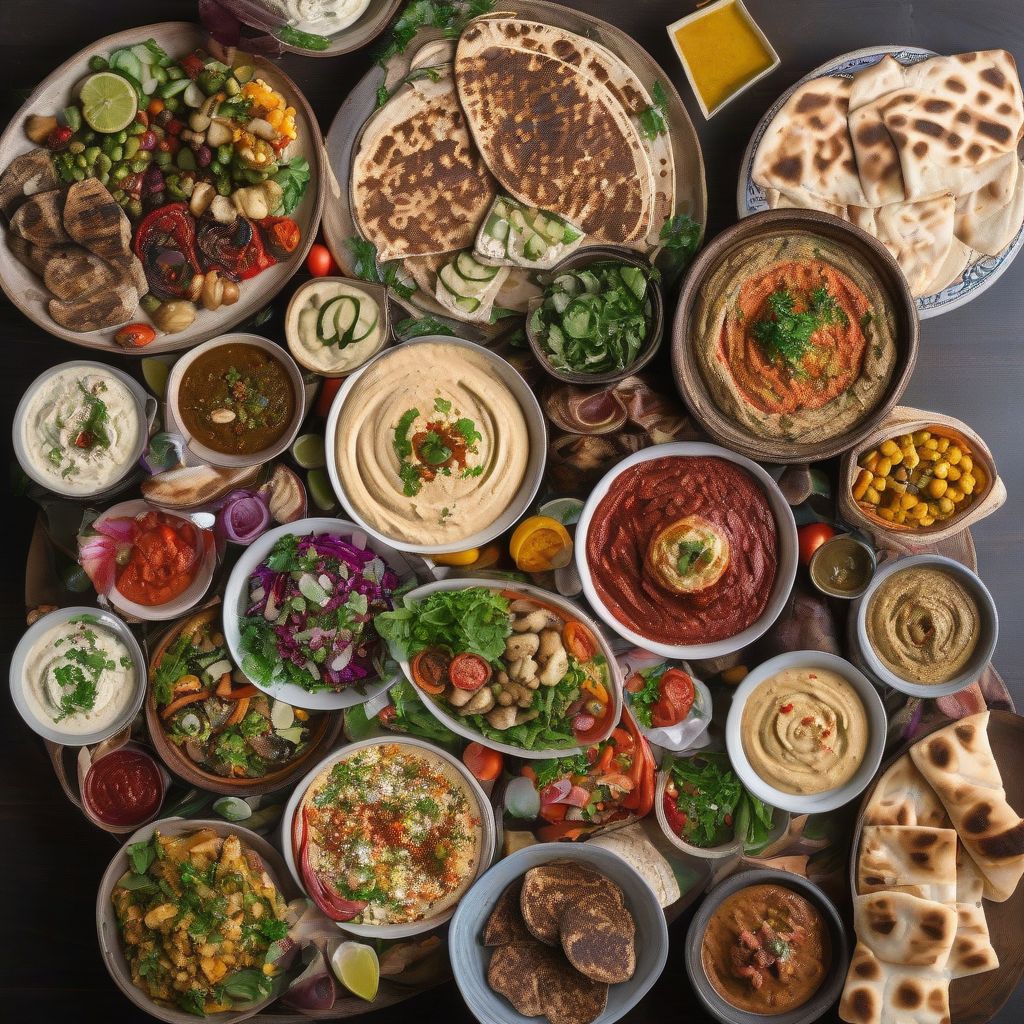Have you ever dreamt of being transported to a bustling Middle Eastern market, the air thick with the aroma of exotic spices and the sounds of lively chatter? What if you could recreate that vibrant atmosphere in your own home, sharing a delicious and unforgettable feast with your loved ones?
Hosting a Middle Eastern-inspired feast is easier than you think! With a little planning and these simple steps, you can create a magical culinary journey for your guests. Let’s gather the ingredients, embrace the rich flavors, and create a feast that tantalizes taste buds and leaves everyone asking for more!
Planning Your Middle Eastern Feast
1. Craft Your Menu: A Tapestry of Flavors
The beauty of Middle Eastern cuisine lies in its diversity, offering a vibrant array of flavors and dishes. To create a balanced and enticing menu, consider incorporating a variety of dishes:
- Mezze Platter: Start with a dazzling spread of small plates like hummus, baba ghanoush, muhammara (roasted red pepper dip), and falafel. These flavorful bites are perfect for sharing and ignite the palate.
- Flavorful Salads: Middle Eastern salads are anything but boring! Think vibrant Fattoush salad with its crunchy pita bread, refreshing Tabbouleh with parsley and bulgur, or a simple yet satisfying cucumber and tomato salad with a lemon-mint dressing.
- Tantalizing Main Courses: The star of your feast could be a slow-cooked tagine with tender lamb and dried fruits, aromatic chicken shawarma, or a flavorful vegetarian dish like stuffed bell peppers with rice and herbs.
- Delectable Sides: Complement your main course with fluffy rice pilaf, couscous, or warm pita bread perfect for scooping up every last drop of sauce.
- Sweet Endings: No Middle Eastern feast is complete without a touch of sweetness! Indulge in baklava with its layers of flaky pastry and honey, creamy rice pudding, or fresh fruit served with a drizzle of honey and chopped pistachios.
2. Set the Stage: Creating an Ambiance of Enchantment
Transport your guests to the heart of the Middle East by creating a warm and inviting ambiance:
- Color and Texture: Think rich, warm colors like jewel tones, gold accents, and luxurious fabrics like velvet and silk. Drape colorful throws over chairs, scatter decorative pillows, and consider a patterned tablecloth for an authentic touch.
- Music: Set the mood with traditional Middle Eastern music or opt for contemporary Arabic fusion for a modern twist. Soft instrumental music can also enhance the dining experience.
- Lighting: Create a warm glow with dimmed lighting, candles, or string lights. Lanterns, both traditional and decorative, add an extra touch of magic.
3. Embrace the Art of Presentation
Presentation is paramount in Middle Eastern culture. Elevate your feast with these tips:
- Serve Mezze-style: Arrange your dips, salads, and small plates on a large platter for a visually appealing and interactive dining experience.
- Garnish Generously: Fresh herbs like mint, parsley, and cilantro not only add flavor but also enhance the visual appeal of your dishes. Sprinkle chopped nuts, pomegranate seeds, or a drizzle of olive oil for a final touch.
- Beautiful Servingware: Use colorful ceramic bowls, platters, and tagines to serve your dishes. Copper serving trays add a touch of authenticity and elegance.
 Middle Eastern Feast
Middle Eastern Feast
Essential Ingredients for Your Middle Eastern Pantry
To recreate the authentic flavors of the Middle East, stock your pantry with these staples:
- Spices: Cumin, coriander, turmeric, cinnamon, cardamom, sumac, and za’atar are essential for adding depth and complexity to your dishes.
- Olive Oil: High-quality olive oil forms the base of many Middle Eastern dishes, adding richness and flavor.
- Tahini: A paste made from sesame seeds, tahini is a key ingredient in hummus, baba ghanoush, and many sauces.
- Legumes: Lentils, chickpeas, and fava beans are versatile ingredients used in soups, stews, salads, and dips.
- Grains: Rice, bulgur, and couscous are staples in Middle Eastern cuisine, served as sides or incorporated into main dishes.
- Herbs: Fresh mint, parsley, cilantro, and dill add brightness and freshness to dishes.
- Nuts and Seeds: Pistachios, almonds, pine nuts, and sesame seeds add crunch, flavor, and visual appeal.
Tips for a Successful Middle Eastern Feast
- Plan Ahead: Many Middle Eastern dishes benefit from marinating or slow cooking, so plan your menu accordingly.
- Prep Ingredients: Save time on the day of your feast by chopping vegetables, making sauces, and measuring out spices in advance.
- Don’t Be Afraid to Experiment: Middle Eastern cuisine is all about adapting recipes to your liking. Feel free to adjust spices, try different herbs, and make each dish your own.
- Encourage Sharing: Middle Eastern meals are traditionally shared, so encourage your guests to sample a variety of dishes and pass plates around the table.
- Most Importantly, Have Fun! Relax, enjoy the process, and savor the delicious flavors of your Middle Eastern feast with your loved ones.
Conclusion
Hosting a Middle Eastern-inspired feast is an invitation to embark on a culinary adventure filled with vibrant flavors, warm hospitality, and unforgettable memories. By following these tips, you can create a truly special experience for your guests that will transport them to the heart of the Middle East. So, gather your loved ones, embrace the spirit of generosity, and savor the magic of a Middle Eastern feast!
What are your favorite Middle Eastern dishes to share with friends and family? Share your thoughts and recipes in the comments below!
[amazon bestseller=”middle eastern cookbook”]
